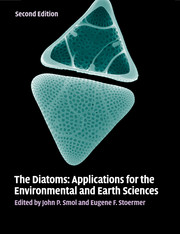Book contents
- Frontmatter
- Contents
- List of contributors
- Preface
- Part I Introduction
- Part II Diatoms as indicators of environmental change in flowing waters and lakes
- Part III Diatoms as indicators in Arctic, Antarctic, and alpine lacustrine environments
- Part IV Diatoms as indicators in marine and estuarine environments
- Part V Other applications
- 24 Diatoms of aerial habitats
- 25 Diatoms as indicators of environmental change in wetlands and peatlands
- 26 Tracking fish, seabirds, and wildlife population dynamics with diatoms and other limnological indicators
- 27 Diatoms and archeology
- 28 Diatoms in oil and gas exploration
- 29 Forensic science and diatoms
- 30 Toxic marine diatoms
- 31 Diatoms as markers of atmospheric transport
- 32 Diatoms as non-native species
- 33 Diatomite
- 34 Stable isotopes from diatom silica
- 35 Diatoms and nanotechnology: early history and imagined future as seen through patents
- Part VI Conclusions
- Glossary, acronyms, and abbreviations
- Index
- References
27 - Diatoms and archeology
from Part V - Other applications
Published online by Cambridge University Press: 05 June 2012
- Frontmatter
- Contents
- List of contributors
- Preface
- Part I Introduction
- Part II Diatoms as indicators of environmental change in flowing waters and lakes
- Part III Diatoms as indicators in Arctic, Antarctic, and alpine lacustrine environments
- Part IV Diatoms as indicators in marine and estuarine environments
- Part V Other applications
- 24 Diatoms of aerial habitats
- 25 Diatoms as indicators of environmental change in wetlands and peatlands
- 26 Tracking fish, seabirds, and wildlife population dynamics with diatoms and other limnological indicators
- 27 Diatoms and archeology
- 28 Diatoms in oil and gas exploration
- 29 Forensic science and diatoms
- 30 Toxic marine diatoms
- 31 Diatoms as markers of atmospheric transport
- 32 Diatoms as non-native species
- 33 Diatomite
- 34 Stable isotopes from diatom silica
- 35 Diatoms and nanotechnology: early history and imagined future as seen through patents
- Part VI Conclusions
- Glossary, acronyms, and abbreviations
- Index
- References
Summary
Introduction
One of the goals of modern archeology is to understand how past communities interacted spatially, economically, socially, and culturally with their biophysical environment (Butzer, 1982). To this end archeologists have developed strong links with zoologists, botanists, and geologists to provide information on the environment of past societies and to help understand the complex relationships between culture and environment. This chapter reviews the role of diatom analysis in such studies, and illustrates how the technique can be applied at a range of spatial and temporal scales to place archeological material in its broader site, landscape, and cultural contexts. In particular, we examine applications to establish the provenance of archeological artefacts, the analysis of archeological sediments and processes of site formation, the reconstruction of local site environments, and the identification of regional environmental processes affecting site location and the function of site networks. We have chosen a small number of examples that best illustrate these applications; other case studies directly motivated by archeological problems may be found in reviews by Battarbee (1988), Mannion (1987), Miller & Florin (1989), and Cameron (2007), while diatom-based studies of past changes in sea level, climate, land use, and water quality that are also relevant to archeological investigation are reviewed elsewhere in this volume (e.g. Cooper et al., this volume; Horton & Sawai, this volume; Fritz et al., this volume; Hall & Smol, this volume).
- Type
- Chapter
- Information
- The DiatomsApplications for the Environmental and Earth Sciences, pp. 514 - 522Publisher: Cambridge University PressPrint publication year: 2010
References
- 4
- Cited by



